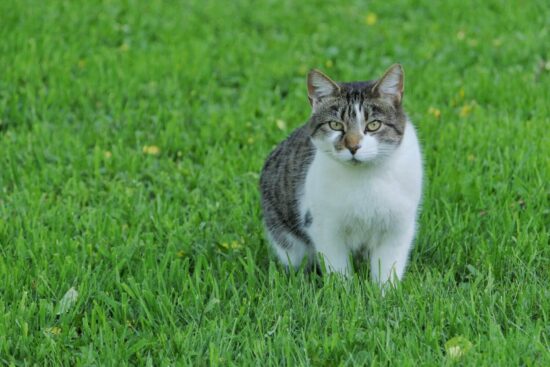Cats wandering into your yard can be frustrating, especially when they dig up your garden, leave unwanted surprises, or stress out your pets. While cats are naturally curious creatures looking for food, shelter, or territory, there are many safe and effective ways to keep them away from your property.
Learning how to keep cats out of your yard doesn’t mean being cruel to these animals. The best solutions protect your space while keeping cats safe and healthy. Whether you’re dealing with neighborhood pets or stray cats, these proven methods will help you reclaim your outdoor space.
1. Set Up Motion Activated Sprinklers and Sound Devices
Motion activated sprinklers are one of the most effective tools for keeping cats out of your yard. These clever devices use sensors to detect when a cat enters your property, then spray a quick burst of water that startles the animal without causing harm.
The ScareCrow Sprinkler is a popular choice that covers up to 1,200 square feet. Most cats learn quickly to avoid areas protected by these devices. The great thing about motion sprinklers is that cats rarely get wet because the sound and sudden movement are enough to send them running.
Ultrasonic devices work similarly but use high pitched sounds instead of water. These sounds are annoying to cats but silent to human ears. Studies show ultrasonic deterrents can reduce cat visits by about 46%. Many models include motion sensors, strobe lights, and can cover areas up to 4,000 square feet.
Both types of devices work best when placed at cat height and positioned to cover main entry points to your yard. Solar powered models save on battery costs, while plug in versions provide consistent power. During winter, you’ll need to bring water based devices inside to prevent freezing.
2. Use Natural Scents and Plant Cat Repelling Vegetation
Cats have incredibly sensitive noses, making scent based deterrents very effective for keeping cats out of your yard. Their sense of smell is about 14 times stronger than humans, so odors we barely notice can be overwhelming to them.
Start with common household items like citrus peels from oranges, lemons, and limes. Scatter these around garden beds and entry points. Coffee grounds work well too and actually help your soil as they break down. White vinegar mixed with water creates an affordable spray that cats hate but won’t harm your plants.
Essential oils like lavender, rosemary, and citronella can be diluted with water to make powerful repellent sprays. Always dilute oils properly since concentrated versions can be too strong. Commercial predator urine products containing coyote or fox scents trigger cats’ natural fear responses.
For a longer lasting solution, plant vegetation that naturally repels cats. Lavender produces beautiful purple flowers while keeping cats away with its strong scent. Rosemary grows into an attractive herb that cats avoid but humans can use for cooking. The scaredy cat plant (Coleus canina) was specifically developed to repel cats and other garden pests.
Citrus scented plants like lemon thyme and citronella grass work especially well. For physical barriers, consider thorny plants like roses or holly bushes around your garden perimeter. Most of these plants are easy to grow and require minimal care once established.
Remember to reapply scent deterrents after rain or watering, and place them around the edges of areas you want to protect rather than just in the center.
3. Create Physical Barriers and Uncomfortable Walking Surfaces
Physical barriers make it unpleasant or impossible for cats to access certain areas. Chicken wire laid over garden beds works incredibly well because cats hate walking on the unstable, pokey surface. You can cut holes in the wire for your plants and cover it lightly with mulch to hide it.
Plastic carpet runners placed spike side up create uncomfortable walkways that cats will avoid. These are perfect for placing on top of cars, around garbage cans, or in favorite lounging spots. Cat deterrent mats with flexible plastic spikes serve the same purpose and won’t hurt cats’ paws.
Change your mulch to materials cats find unpleasant. Pine cones, holly clippings, and lava rocks create scratchy surfaces cats prefer not to walk on. River rocks or gravel work well too and look attractive in garden beds.
For targeted protection, push chopsticks or bamboo skewers into soil around individual plants. Space them about 2 inches apart so cats can’t find comfortable spots to dig. Hardware cloth (wire mesh) can protect specific valuable plants or small garden areas.
Aluminum foil laid on surfaces creates noise and texture that most cats dislike. Double sided tape on railings or fence tops feels awful on cat paws. These simple solutions cost very little but can be quite effective for smaller problem areas.
4. Install Cat Proof Fencing and Specialized Barriers
If cats are consistently entering your yard, upgrading your fencing might be the answer. Regular fences don’t stop cats since they’re excellent climbers and jumpers, but specialized cat proof systems can keep them out effectively.
Fence rollers are cylinders that spin when cats try to grab the top of your fence. Systems like Oscillot use a series of spinning paddles that make it impossible for cats to get a grip. These can be installed on most existing fences and blend in well with your yard.
Angled fence toppers extend your fence height while angling inward or outward to prevent cats from climbing over. Wire mesh extensions that bend toward your property create an overhang that cats can’t navigate around.
For the most effective barrier, fences should be at least 6 feet tall. Smooth materials like vinyl work better than wood because cats can’t dig their claws in for grip. Make sure to check for gaps at ground level, as cats can squeeze through surprisingly small spaces.
Professional installation ensures these systems work properly, but many are designed for DIY setup. While fencing solutions require a bigger upfront investment, they provide long term protection without ongoing maintenance like scent deterrents need.
5. Remove What Attracts Cats and Modify Your Landscape
One of the smartest approaches to how to keep cats out of your yard is removing the things that draw them there in the first place. Cats visit yards looking for food, water, shelter, and hunting opportunities.
Secure your garbage cans with tight fitting lids or bungee cords. Even small amounts of food waste can attract cats from blocks away. Never leave pet food outside, especially overnight when cats are most active. Clean up any spilled birdseed regularly since it attracts rodents that cats hunt.
Block access to potential shelter spots under decks, porches, sheds, and bushes. Use lattice work, wire mesh, or wooden boards to close off these cozy hiding places. Check for any openings where cats might squeeze through and seal them up.
Modify your landscaping to make it less appealing to cats. They prefer loose, dry soil for digging and elimination, so keep garden beds moist and well planted. Dense plantings leave less open soil for cats to use. Ground cover plants create natural barriers that cats don’t like walking through.
Switch to plant based fertilizers instead of fish, blood, or bone meal products that smell appealing to cats. These organic fertilizers actually attract cats to your garden beds, which is the opposite of what you want.
Clean any areas where cats have already been with enzyme based cleaners designed for pet odors. Regular soap won’t remove the scent markers that tell other cats the area is available for use.
6. Try Multiple Sensory Deterrents for Maximum Impact
Combining different types of sensory deterrents often works better than relying on just one method. Cats can get used to single deterrents over time, but multiple unpleasant experiences keep them guessing.
Wind chimes create unpredictable sounds that many cats find unsettling. Hang them near entry points or problem areas where breezes will keep them moving. For more direct action, keep a shake can filled with coins or marbles handy to rattle when you see cats in your yard.
Reflective tape or old CDs hung from trees create flashing lights that startle cats. These work especially well on sunny days when light movement is most noticeable. Pinwheels and other moving decorations can have similar effects.
Commercial spike mats provide larger coverage than individual deterrent strips. Place these in areas where cats like to lounge or walk. The flexible spikes feel uncomfortable but won’t injure cats.
Motion activated devices that make noise, like small alarms or recordings of dog barks, can be effective supplements to other methods. Some cats are more sensitive to sound than others, so this works better in some situations.
The key is changing your deterrent methods every few weeks. Cats are smart and will eventually figure out that most deterrents aren’t actually dangerous. Rotating between different approaches keeps them uncertain and more likely to stay away.
7. Provide Alternative Spaces to Redirect Cat Behavior
Sometimes the best strategy for keeping cats out of your yard is giving them somewhere better to go. This approach works especially well when dealing with neighborhood cats that aren’t going anywhere.
Set up a designated cat area in a corner of your property that’s away from your main garden or outdoor living space. Include some loose soil or sand for digging, along with a few plants cats enjoy like catnip or cat grass. This gives them what they’re looking for without ruining your prized flower beds.
Catnip planted strategically can work like a magnet to draw cats away from areas you want to protect. Plant it in spots where you don’t mind cats hanging out. Most cats find fresh catnip irresistible and will spend their time there instead of in your vegetable garden.
If cats are using your yard for elimination, consider setting up an outdoor litter area with sand or fine gravel. Place it away from your house and garden but still accessible. This might seem like encouraging cats, but it’s better than having them use your entire yard as a bathroom.
Work with neighbors who feed stray cats to set up proper feeding stations away from your property. Well designed feeding areas keep cats in one location and reduce their need to roam through multiple yards looking for food.
Some communities have had success with shared cat deterrent systems where neighbors split the cost of larger solutions like professional fencing or commercial deterrent devices.
8. Talk to Neighbors and Build Community Solutions
Communication is often the most important part of keeping cats out of your yard long term. Many cat problems can be solved through friendly conversations with neighbors who own the cats or care for strays.
Start by identifying which cats are pets and which are strays. Pet cats usually look healthier and may wear collars. If you can figure out who owns them, a polite conversation often solves the problem quickly. Most cat owners don’t realize their pets are causing issues and are happy to help find solutions.
For stray or feral cats, learn about TNR programs in your area. TNR stands for Trap, Neuter, Return and helps control cat populations humanely. Spayed and neutered cats are less likely to roam, fight, spray, or make noise. Many communities have organizations that provide TNR services for free or at low cost.
Share information about humane deterrent methods with neighbors who might be having similar problems. Pool resources to buy more expensive solutions like ultrasonic devices or motion sprinklers that can protect multiple properties.
Keep written records of any cat related problems, including dates, times, and photos if possible. This documentation can be helpful if you need to involve animal control or local authorities later.
Educate neighbors about why removing cats isn’t a good solution. Most animal shelters are overcrowded, and outdoor cats often don’t adapt well to indoor life. Working together on deterrent strategies benefits everyone in the neighborhood.
9. Adapt Your Methods for Different Seasons and Weather
Effective cat deterrents need to change with the seasons. Weather affects how well different methods work, and cat behavior changes throughout the year too.
During winter, motion activated sprinklers can’t be used in areas where water might freeze. Switch to ultrasonic devices, scent deterrents, or physical barriers during cold months. Cats also seek warm shelter more actively in winter, so check for new hiding spots under decks or in garages.
Summer heat makes scent based deterrents evaporate faster, so you’ll need to reapply them more frequently. Essential oil sprays work better in cooler parts of the day when they won’t disappear as quickly. Increase watering of garden beds since cats prefer dry soil for digging.
Rain washes away most scent deterrents, so have backup methods ready. Physical barriers like chicken wire or spike mats work regardless of weather. After storms, do a quick check of your deterrent systems and reapply what’s needed.
Spring brings mating season, which means cats roam more widely looking for mates. This is when TNR programs become especially important for controlling stray populations. It’s also prime time for installing new deterrent systems before cats establish routines in your yard.
Fall means cats are preparing for winter and looking for reliable food sources and shelter. Clean up fallen fruit from trees and secure compost piles that might attract prey animals. This is also a good time to block access to potential winter hiding spots.
Different deterrent devices need seasonal maintenance too. Solar panels on electronic devices should be cleaned regularly. Battery powered devices need fresh batteries before winter when power drains faster.
10. Consider Professional Help and Advanced Commercial Systems
When basic methods aren’t enough, professional solutions can provide the extra power needed for keeping cats out of your yard permanently. These options cost more upfront but often save time and frustration in the long run.
Professional pest control companies that specialize in wildlife can assess your specific situation and recommend targeted solutions. They have access to commercial grade deterrent systems that aren’t available to consumers and can install them properly for maximum effectiveness.
Advanced ultrasonic systems can cover much larger areas than consumer models and often include features like remote monitoring and smartphone controls. Some commercial units can protect entire properties and automatically adjust their settings based on detected animal activity.
Automated spray systems go beyond simple motion sprinklers by using sophisticated sensors and programmable spray patterns. These systems can differentiate between cats and other animals or even people, reducing false activations.
Professional fencing installation ensures cat proof barriers are built correctly and will last for years. Companies that specialize in pet containment understand exactly how cats move and can design systems that account for their jumping and climbing abilities.
For persistent problems, consider hiring an animal behaviorist who can identify exactly why cats are attracted to your property and design a custom deterrent plan. Sometimes the issue isn’t obvious, and professional observation can spot things homeowners miss.
Smart deterrent technology allows you to monitor and control systems remotely. Some units include cameras so you can see when cats approach and activate deterrents manually. Others learn from cat behavior patterns and become more effective over time.
Before investing in expensive solutions, make sure you’ve tried multiple basic methods consistently for several weeks. Professional help works best when combined with good maintenance of simpler deterrents like scent barriers and physical obstacles.
Understanding local laws about animal control and neighbor responsibilities can help you know when professional intervention is appropriate and what options are available through municipal services.
Conclusion
Learning how to keep cats out of your yard takes patience and often requires trying several different approaches. The most successful solutions combine multiple methods and focus on making your property less attractive to cats rather than just scaring them away.
Start with simple, inexpensive options like scent deterrents and physical barriers. These methods work well for many situations and help you understand which approaches cats in your area respond to best. Motion activated sprinklers and ultrasonic devices provide the next level of protection for more persistent problems.
Remember that keeping cats out of your yard works best when neighbors cooperate and when solutions address the root causes that bring cats to your property in the first place. Removing food sources, blocking shelter spots, and modifying your landscape often prevent problems better than any deterrent device.
The goal is finding humane solutions that protect your property while keeping cats safe. With the right combination of methods and consistent application, you can enjoy your outdoor space without unwanted feline visitors.


